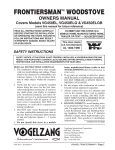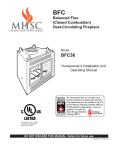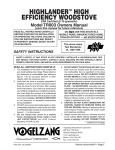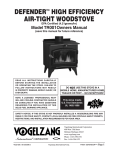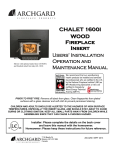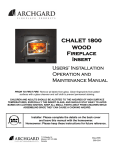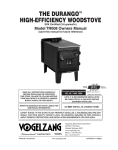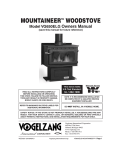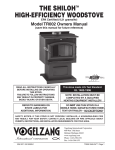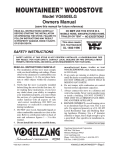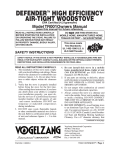Download Vogelzang International VG2500 Instruction manual
Transcript
Frontiersman™ Woodstove Owners Manual Covers Models VG450EL, VG450ELG & VG450ELGB (save this manual for future reference) This stove meets U.S. Test Standard: READ ALL INSTRUCTIONS CAREFULLY BEFORE Installing OR OPERATING This STOVE. Failure to follow instructions may result in property damage, bodily injury, or even death. Refer to markings on STOVE labels for additional information. UL 1482-1996 NOTE: It is recommended Installation be completed by a qualified Heating Equipment Installer! Do NOT install in a mobile home. Safety Notice: If this stove is not properly installed, a house/building fire may result. For your safety, contact local or municipal building or fire officials about permits, restrictions, and installation requirements for your area. Vogelzang International Corporation 400 West 17th Street Holland, Michigan 49423 www.vogelzang.com Phone: 1-616-396-1911 Fax: 1-616-396-1971 VGZ-014 / 20120424.0 Vogelzang International Corp. VG450EL Frontiersman™ / Page 1 SAFETY INSTRUCTIONS 1.The installation of this stove must comply with your local building code rulings. Please observe the clearances to combustibles (see reference figures 1– 3). Do not place furniture or other objects within the clearance area. 2. Verify that the stove is properly assembled and installed before firing the stove for the first time. After reading these instructions, if you have any doubt about your ability to complete your installation properly, you must obtain the services of a professional licensed installer familiar with all aspects of safe and correct installation. DO NOT use temporary or makeshift compromises during installation. There must be no deviation or alteration of any kind from the very specific instructions spelled out in this instruction manual as it pertains to the installation of this woodstove. NO EXCEPTIONS! 3. DO NOT store wood, flammable liquids or other combustible materials too close to the unit. Refer to certification label on back of unit and reference figures 7 – 9 in this manual. 4. Do not install this stove in a mobile home, manufactured home, trailer or tent – NO EXCEPTIONS! (HUD Federal Standard: 24 CFR Ch.XX). 5. Do not elevate this stove by any means. (i.e. bricks under legs, cement blocks) Stove legs must set directly upon the solid-surface non-combustible floor as specified in this stove instruction manual. Do not modify this stove in any way! Stove must be installed with legs provided, attached as shown in the instructions. Assemble only with original parts as supplied and shown in this manual. DO NOT OPERATE A STOVE THAT IS MISSING ANY PARTS! If any parts are missing or defective, please notify the dealer or manufacturer immediately. Replace missing, broken or worn parts with factory original or equivalent parts only. 6. CAUTION: Do not alter combustion air control range to increase firing or for any reason. Altering or tampering with air control beyond normal capacity will create unsafe and hazardous conditions. 7.Always connect this stove to a chimney and vent to the outside. Never vent to another room or inside a building. DO NOT CONNECT THIS UNIT TO A CHIMNEY FLUE SERVING ANOTHER APPLIANCE. 8. Do NOT connect a wood burning stove to an aluminum Type B gas vent. This is not safe. Use code-approved lined masonry or a UL 103 HT Listed Residential Type and Building Heating Appliance chimney. Use a 6” diameter chimney or larger, that is high enough to give a good draft. (See specifics in installation instructions). Page 2 / VG450EL Frontiersman™ 9. Be sure that your chimney is safely constructed and in good repair. Have the chimney inspected by the fire department or a qualified inspector. Your insurance company should be able to recommend a qualified inspector. Chimney connector pipe must be in good condition. Replace if necessary before using stove. 10. Creosote or soot may build up in the chimney connector and chimney and cause a house/building fire. Inspect the chimney connector and chimney twice monthly during the heating season and clean if necessary. (See Service Hints, page 14) 11. In the event of a chimney fire, turn the damper control to closed position, leave the building and CALL THE FIRE DEPARTMENT IMMEDIATELY! Have a clearly understood plan on how to handle a chimney fire by contacting your local fire authority for information on proper procedures in the event of a chimney fire. After the fire is out, the chimney must be cleaned and inspected for any stress or cracks before starting another fire. Check the condition of any combustibles surrounding the chimney. 12.To prevent injury, do not allow anyone to use this stove who is unfamiliar with the correct operation of the stove. 13. Do not allow ashes to accumulate above top of ash drawer. 14. Disposal of Ashes Ashes should be placed in a steel container with a tight fitting lid and moved outdoors immediately. The closed container of ashes should be placed on a noncombustible floor or on the ground, well away from all combustible materials, pending final disposal. If the ashes are disposed of by burial in soil or otherwise locally dispersed, they should be retained in the closed container until all cinders have completely cooled. Other waste shall not be placed in this container. 15.The special paints used on your stove may give off some smoke and an odor while they are curing during the first 12 to 15 fires. Additional smoke and odor may be emitted from the light oils used in construction of the fire box. This should disappear after a short period of time and not occur again. Persons with lung conditions or owners of susceptible domestic pets (such as birds) should take pr udent precautions. Open windows and doors as needed to clear smoke and/or odor. Paint discoloration will occur if the stove is over fired. 16. This stove has a painted surface which is durable but it will not stand rough handling or abuse. When installing your stove, use care in handling. 17. DO NOT ELEVATE THE FIRE. Build fire directly on the bottom of the firebox. This stove has not been tested with the use of grates, andirons or other means of elevating the fire and must not be used. www.vogelzang.com VGZ-014 / 20120424.0 SAFETY INSTRUCTIONS continued… 18. Clean stove frequently as soot, creosote and ash may accumulate. Clean exterior with soap and warm water when stove is not hot. Do not use any acids or scouring soap, as these solvents wear and dull the finish. 19. Do not operate stove while under the influence of drugs or alcohol 20. Alert all persons to the hazards of high surface temperatures while stove is in operation – especially young children. Keep away from a hot stove to avoid burns or clothing ignition. 21. Never leave small children unsupervised when they are in the same room as the stove. If small children will be in the same room as the stove during operation, provide a sturdy barrier to keep them at a safe distance from the stove. 22. Keep stove area clear and free from all combustible materials, gasoline, engine oil, naphtha and other flammable vapors and liquids. 23. While tending the fire always wear protective clothing, fire retardant hearth gloves and eye protection, to prevent burns. 24. Never operate this stove with the door open except when re-fueling. Such actions can result in very dangerous operating conditions. 25. Do not over fire the stove. Over firing will occur if combustion air is uncontrolled as when operated with the feed door left open during operation. Such actions can result in very dangerous operating conditions. While in operation, keep the feed door closed and secured at all times except while tending the fire 26. Do not smother fire when adding fuel. Do not build fires against glass and do not load fuel to a height or in such a manner that it creates a hazard when opening the door. 27. NEVER LEAVE THE STOVE UNATTENDED with door open. Always close the door after ignition. 28. DO NOT CONNECT TO OR USE IN CONJUNCTION WITH ANY AIR DISTRIBUTION DUCT WORK UNLESS SPECIFICALLY APPROVED FOR SUCH INSTALLATIONS. 29. A wood-burning stove MUST Never be installed in a hallway or near a staircase, as it may block egress in the event of a fire. 30. Do not install in a sleeping room. 31. Do not install in an alcove or inside a fireplace. 32.Install at least one smoke detector on each floor of your home. Detectors should be located away from the heating appliance to avoid false alarms. Detectors should be located close to sleeping areas. Follow the smoke detector manufacturer’s placement and installation instructions. Maintain smoke detector per manufacturer’s instructions. VGZ-014 / 20120424.0 33. Carbon Monoxide (CO) Hazard. A buildup of CO fumes is toxic and can be fatal. Carbon Monoxide is a colorless, odorless gas produced during combustion of wood, coal, oil, gas and by other fuel burning appliances. It is important to have a proper draft and adequate replacement air ventilation so fumes are drawn out the chimney. Installed as instructed this stove is designed to be as safe as possible yet it is recommended to install a CO detector. Follow the manufacturer’s recommendations for proper installation and use. It is recommended to be placed at table-top level (not near the ceiling) to avoid false alarms. Realize that devices other than a stove (i.e. motor exhaust) can trigger CO alarms. If alarm sounds: • Recognize the symptoms of CO poisoning (headaches, nausea & drowsiness). • Increase ventilation (open windows & doors). • Make sure stove doors and/or lids are closed and secured. • Check stove for smoking or puffing (open airflow controls). • Check chimney & connector pipe for leaks, blockage or down-draft conditions. • Check CO device for false alarm. 34.The walls of the fire box may become slightly distorted after a period of use. A slight distortion will not affect 34 operation of the stove. 35. Keep power cords, electrical appliances and/or assemblies outside of the clearance area shown in this manual for combustible materials. 36. Consult your municipal building department or fire officials about restrictions, permits and installation requirements for your area. 37. For fur ther information on using your stove safely, a copy of the National Fire Protection Association (NFPA) publication, “Using Coal and Wood Stoves Safely” NFPA No. HS-10-1978. Write NFPA, Batterymarch Park, Quincy, MA 02269. Vogelzang International Corp. VG450EL Frontiersman™ / Page 3 Assembly Instructions NOTICE: Vogelzang International Corp. grants no warranty, stated or implied, for the installation or maintenance of your wood stove and assumes no responsibility of any incidental or consequential damages. Tools and Materials Required for Installation materials tools (NOTE: The following items are not included with your stove) Flooring Protection: 40” x 48” as specified (see page 4) Safety Glasses & Gloves Pencil Chimney Connection: 6” dia. minimum 24 MSG black or 26 MSG blue steel straig ht stove pipe or elbow(s) as required. 1/2” Sheet Metal Screws Chimney: Existing 6” lined masonry chimney or 6” inside dia. manufactured chimney system listed to UL 103 HT. Furnace Cement (manufacturer recommends Rutland Code 78 or equivalent) 6 foot Folding Rule or Tape Measure Tin Snips Drill: Hand or Electric 1/8” dia. Drill Bit (sheet metal screws) Screwdrivers (blade and Phillips type) 14mm Nut Driver or Ratchet with 14mm Socket CAUTION: Stove is heavy. Make sure you have adequate help and use proper lifting techniques whenever moving stove. 14mm nuts removed in step 4. Tighten nuts securely. 6. Carefully lift stove to upright position. WARNING: Metal panel fastened between legs acts as a heat deflector. This panel must be in place for safe operation. 1. Uncrate the stove and remove cardboard packing, styfofoam and protective poly bag. Remove rear deflector (#21) from the carton. 7. Attach rear deflector to the rear side corners of the stove using four screws. (Save cardboard for further assembly.) 2. Remove parts from inside stove. Parts in- 8. On VG450ELGB models (only), attach blower assembly to rear of heat deflector. clude: one damper collar (#1), four legs (#16), NOTE: Make sure ceramic gasket is positioned hardware pack (#22) and air deflectors (#33) between rear deflector and blower assembly. located inside firebox. Attach two (2) air deflectors (#33) to the top 3. Place flattened carton behind stove and careof the rear heat deflector. When installed, the fully turn stove over onto its back on carton. angled lip should face towards the front of the 4. Remove the four 14mm nuts holding the stove. bottom floor shield in place. 5. Without removing the floorshield, place each 9. Attach damper collar to rear top surface of stove using machine screws. leg in position and secure using the four (4) Locating Stove CAUTION: (Fire Hazard) Carpeting and 1. The stove must be placed on solid concrete, other combustible material Must not solid masonry, or when installed on a comcover the floor protector. These bustible floor, on a listed UL1618 type 2 floor materials must remain outside of protector, such as Hy-C or Imperial Model combustible clearances, see fig. 1– 3. UL 4048BK or equivalent with 0.8 R-factor. (NOTE: to calculate R-value of alternative 2. The stove must have its own flue. Do not connect this unit to a chimney materials see page 16). The base must extend flue serving other appliances. at least 16” beyond the side with the access door, 8” to the sides of fuel opening, 8” behind 3. After observing the clearances to combusthe stove, and must extend under the stove tible materials (figures 1–3), locate your floor pipe and 2” beyond each side if it is elbowed protector accordingly (figure 1) and caretowards a wall. (See figures 1 & 3 and consult fully place the stove in your selected location. local building codes and fire protection ordiInstall connector pipe, elbows, and thimble as nances) Continued on next page Page 4 / VG450EL Frontiersman™ www.vogelzang.com VGZ-014 / 20120424.0 Locating Stove continued… required, utilizing either a recently cleaned CAUTION: Keep furnishings and other combustible materials away form the and inspected 6˝ masonry chimney or a 6˝ i.d. stove. manufactured chimney listed to UL 103 HT. 4. Use round 6˝ dia., minimum 24 MSG (miniNOTE: Before firing woodstove slide mum standard gauge) black or 26 MSG blue firebricks towards the rear so no steel stove pipe to connect the stove to the gaps remain between bricks. chimney. Do not use galvanized duct pipe. Secure pipe sections with three (3) sheet metal screws in each stove pipe and/or elbow joint to 6. Do Not install this stove in a mobile firmly hold the pipe sections together. Screws home, Manufactured Home, Tent or trailer – NO EXCEPTIONS! (HUD Federal may be no more than a maximum of 3˝/76mm Standard: 24 CFR Ch.xx) apart. Do not connect this stove to any air distribution or duct 7. The clearances provided are minimum system. dimensions determined by the manufacturer’s testing laboratory shown on the front cover. 5. R e c h e c k c l e a r a n c e s f r o m t h e s t ove , Installation of this stove must comply with the connector stove pipe, and corner clearances latest edition of NFPA 211 for reduced clearusing the illustrations in figures 1–3 and ances and/or your local building code rulings. your local building codes or fire protection Use whichever minimum dimensions are ordinances. LARGEST. NOTE: a wall faced with drywall, 8. This stove meets U.S. Test Standard: brick or stone must be considered UL 1482-1996. a combustible surface. TOP VIEW COMBUSTIBLE CONSTRUCTION IN ACCORDANCE WITH NFPA 211 DASHED LINE SHOWS HORIZONTAL CHIMNEY CONNECTOR AND ADDITIONAL FLOOR PROTECTOR REQUIRED EXTENDING BENEATH AND 2” BEYOND EACH SIDE. BACKWALL 40" 33"min 8"min. 48" 17" SIDEWALL 28" min. FLOOR PROTECTOR 24" CORNER CLEARANCES 16"min. 8"min. 28" Fig. 1 – Top View Minimum Clearance Dimensions from Combustible Surfaces 28" Fig. 2 – Top View Minimum Corner Clearances from Combustible Surfaces VGZ-014 / 20120424.0 Vogelzang International Corp. VG450EL Frontiersman™ / Page 5 Locating Stove continued… Fig. 3a – Front View Minimum Clearance Dimensions from Combustible Surfaces Fig. 3b – Side View Minimum Clearance Dimensions from Combustible Surfaces connector Pipe Installation 6. It is recommended that no more than two (2) 90° bends be used in the stovepipe installation. The use of more than two 90° bends may decrease the amount of draw and possibly cause smoke spillage. Where possible, use only corrugated (nonadjustable) elbows. These The straight end of the stovepipe fits over the provide a better seal. stove flue collar. Secure with three (3) sheet 7. The connector pipe must not pass through an metal screws. attic or roof space, closet, or any concealed Horizontal pipe runs must slope upwards space, or floor, ceiling, wall or combustible towards the chimney at least 1/4” per foot of construction. (See Chimney Connector Syshorizontal run. This allows any condensation tems & Clearances, page 10). A manufactrured in the pipe to drain back into the firebox. chimney system listed to UL 103 HT must You must have at least 18 inches of clearance be used from the first penetration of ceiling or between any horizontal piping and the ceiling. wall to the chimney cap. Any wall or ceiling The pipe cannot extend into the chimney flue penetrations must conform to NFPA 211. (figure 4). Secure the pipe/flue collar and all pipe/elbow WARNING: Do Not use single wall connector pipe as a chimney - a house fire sections with three (3) sheet metal screws at could result. each joint to make the piping rigid. Screws may be no more than a maximum of 3˝/76mm apart. NOTE: Stove pipe is NOT INCLUDED. To purchase, Visit your local hardware, home or building center. See “Locating Stove” page 3 for additional specifications. 1. 2. 3. 4. 5. CORRECT WRONG WRONG Fig. 4 – Stovepipe/Flue Connections Page 6 / VG450EL Frontiersman™ www.vogelzang.com VGZ-014 / 20120424.0 Chimney connections The stove must be connected to either a masonry or manufactured metal chimney built and tested to the specifications listed on the previous pages. Chimneys perform two functions: 1). As a means of exhausting smoke and flue gases which are the result of fuel combustion. 2). The chimney provides “draft” which allows oxygen to be continuously introduced into the appliance, so that proper combustion is possible. This stove relies on natural draft to operate. NOTICE: Always provide a source of fresh air into the room where the stove is located. Failure to do so may result in air starvation of other fuel burning appliances and the possible development of hazardous conditions, fire or death. Your stove itself does not create draft. Draft is provided by the chimney. To achieve proper draft your chimney must meet the three minimum height requirements detailed in figures 7–9. A minimum of 0.05 w.c. (measured in water column) is required for proper drafting to prevent back puffing, smoke spillage, and to maximize performance. (Gauges to measure draft are readily available at stove stores and are economical to rent or purchase.) Factors such as wind, barometric pressure, trees, terrain and chimney temperature can have an adverse effect on the draft. The manufacturer cannot be held responsible for external factors leading to less than optimal drafting. Should you have a problem with inadequate draft, you should contact a licensed heating and cooling contractor for assistance in solving the problem. IMPORTANT Installation Points 1. Size chimney flue to stove collar. This stove requires a 6” diameter flue. 2. Never connect this unit to a chimney serving another appliance. 3. The chimney must meet all minimum height requirements. 4. Never use a chimney to ventilate a cellar or basement. 5. Contact your local building authority for approved methods of installation and any necessary permits and/or inspections. Masonry Chimney Chimney must be a code-approved, masonry chimney with flue liner. Before using an existing masonry chimney, clean the chimney, inspect the flue liner and make any repairs needed to be sure it is safe to use. Make repairs before attaching the stove. The connector stove pipe and fittings you will need to connect directly to a masonry chimney are shown in figure 6. THIMBLE 6˝ ROUND 24 ga. BLACK CONNECTOR STOVEPIPE COLLAR CHIMNEY FLUE 5/8" TILE CHIMNEY LINER 8˝ MIN. LINER BELOW ENTRY HOLE MASONRY CHIMNEY Fig. 6 - Masonry Chimney Connection If the connector stove pipe must go through a combustible wall before entering the masonry chimney, consult a qualified mason or chimney dealer. The installation must conform to local building and fire codes and latest edition of NFPA 211. If there is a cleanout opening in the base of the chimney, close it tightly. Fig. 7 - Chimney Construction Through Attic Space VGZ-014 / 20120424.0 Vogelzang International Corp. VG450EL Frontiersman™ / Page 7 Chimney connections continued … Manufactured Chimney Refer to chimney and chimney connector maker’s instructions for installation and use. Use only 6˝ diameter manufactured chimney system listed to UL 103 HT. Chimney made to this listing is High Temperature rated to 2100 degrees Fahrenheit. Use chimney from only one manufacturer. Never mix brands. Carefully follow the chimney manufacturer’s stated requirements and clearances. Use the chimney manufacturer’s attic guards, roof supports, flashing and fire stops when passing through a ceiling. Use a listed thimble when passing through a combustible wall. Do not use makeshift compromises during installation. Warning: Do Not use a single-wall connector pipe as a chimney! Fig. 8 - Chimney Construction Through Roof Fig. 9 - Chimney Connection to Firebox Through Masonry Wall When using a pre-existing chimney, have it’s condition and installation inspected before using. Make sure that the chimney meets all of the UL rating requirements listed above. Be aware that not all manufactured chimney is of the UL 103 HT type. NOTE: It is recommended that you contact a licensed heating and cooling contractor (consult your local yellow pages) for chimney installation. Manufactured chimney with the proper required UL listing is available from most home centers, hardware stores, and HVAC supply stores. If you have access to the internet, you may wish to view chimney manufacturers’ information on-line. See, www.duravent.com, www. selkirkinc.com, or www.mtlfab.com. Venting to Existing Fireplace In some instances, people desire to convert an existing fireplace for stove use. Usually, safe connection to an existing masonry chimney requires more work than using a prefabricated chimney. The existing fireplace must be closed and sealed at the damper with high-temperature caulk, ceramic wool, or furnace cement. Prior to installation, clean and inspect the existing flue and smoke shelf. Installation should be designed so the system can be dismantled for periodic cleaning and inspection. Before conversion, make sure the existing chimney is structurally sound, the chimney incorporates a flue liner and make sure it is in good condition. (A flue liner consists of clay tile that protects the Continued on next page Page 8 / VG450EL Frontiersman™ www.vogelzang.com VGZ-014 / 20120424.0 Chimney connections continued … brickwork of a chimney. If a chimney does not trimwork, ceilings and walls. Positioning the center of the stove pipe entry into the chimney have a liner, or it is damaged, have it relined by a 24” below the ceiling should insure proper professional. Do Not use a chimney that is clearance for a 6” stovepipe. unlined or damaged!) If you have any question regarding the condition of the chimney, 2. Install a fire clay (5/8˝ minimum thickness) thimble. Make sure the thimble is flush with consult a qualified licensed contractor, qualified the inner surface of the chimney liner and does engineer, competent mason, certified Chimney not protrude into the flue (see figure 6). Sweep, or a knowledgable inspector. Consult your 3. Secure the thimble with refractory mortar. The insurance company if you cannot find a qualified thimble should be surrounded by 12˝ of solid expert. unit masonry brickwork or 24˝ of stone. 4. Install the stovepipe into the thimble as far as CAUTION: Not all fireplace possible without extending past the flue lining c h im n e ys a r e s u itable fo r (see figures 4 & 6 on pages 5& 6). conversion to accommodate 5. A small airspace (about 1/2˝) should remain connection to a wood stove. between the stovepipe and thimble to allow for Check with a qualified expert. expansion of the pipe. Seal this airspace with high-temperature caulking or ceramic wool. Many prefabricated fireplaces are of the “zero6. Secure and seal the damper in the closed posiclearance fireplace” category. These consist of tion using high-temp caulking, ceramic wool, multilayered metal construction. Connecting a or furnace cement. Also check to see if the stove to such a device will void the manufacturer’s chimney has a cleanout. If it does, make sure it warranty. is closed and sealed as well. A leaky cleanout Venting a stove directly into a fireplace does will greatly reduce draft efficiency. not meet code and should not be attempted. (This If you have any questions regarding venting constitutes connection to another appliance - the your stove, contact the manufacturer or contact fireplace.) Combustion products will be deposited the National Fire Protection Association (NFPA) and build up in the firebox or fireplace. The stove and request a copy of the latest editions of NFPA warranty will be void with such an installation. Do Standard 211 and NFPA Standard 908. Their adnot create a hazard in your home by connecting in dress is: this manner. Battery March Park, Quincy, MA 02269. Fireplace Installation Directly connecting the stovepipe into the existing masonry chimney (figure 10 “Type A” Fireplace Conversion) of the fireplace is the only approved method of installation. This is a complicated and involved process and to insure safety should only by done by a qualified installer. 1. An entry hole must be cut through the masonry and tile liner with minimal damage to the liner. At least 8˝ of liner must remain below the entry position. When locating the stove and stovepipe, all minimum clearances must be observed from combustible surfaces including mantels, combustible VGZ-014 / 20120424.0 Continued on next page FIG. 10 - Fireplace Conversion Vogelzang International Corp. VG450EL Frontiersman™ / Page 9 Chimney Connector Systems & Clearances A. Brick Masonry Minimum 3.5˝/89mm thick brick masonry all framed into combustible wall with a minimum of 12˝/305mm brick separation from clay liner to combustibles. The fireclay liner shall run from outer surface of brick wall to, but not beyond, the inner surface of chimney flue liner and shall be firmly cemented in place. B. Insulated Sleeve Solid-insulated, listed factory-built chimney length of the same inside diameter as the chimney connector and having 1˝/25.4cm or more of insulation with a minimum 9˝/229mm air space between the outer wall of the chimney length and combustibles. C. Ventilated Thimble Sheet steel chimney connector, minimum 24 gauge in thickness, with a ventilated thimble, minimum 24 gauge in thickness, having two 1˝/25.4mm air channels, separated from combustibles by a minimum of 6˝/152mm of glass fiber insulation. Opening shall be covered, and thimble supported with a sheet steel support, minimum 24 gauge in thickness. D. Chimney Section Pass-through Page 10 / VG450EL Frontiersman™ Solid insulated, listed factory-built chimney length with an inside diameter 2˝/51mm larger than the chimney connector and having 1˝/25.4mm or more of insulation, serving as a pass-through for a single wall sheet steel chimney connector of minimum 24 gauge thickness, with a minimum 2˝/51mm air space between the outer wall of chimney section and combustibles. Minimum length of chimney section shall be 12˝/305mm chimney section spaced 1˝/25.4mm away from connector using sheet steel support plates on both ends of chimney section. Opening shall be covered, and chimney section supported on both sides with sheet steel support securely fastened to wall surfaces of minimum 24 gauge thickness. Fasteners used to secure chimney section shall not penetrate chimney flue liner. www.vogelzang.com VGZ-014 / 20120424.0 Operating Instructions CAUTION: HOUSE FIRE HAZARDS • Do not store wood on floor protector, underneath stovepipe or anywhere within minimum clearances from combustible surfaces specified for this stove. • Overfiring may cause a house fire. You are overfiring If a unit or chimney connector glows Red. Operating Safety Precautions 1.Never overfire this stove by building excessively hot fires as a house/ building fire may result. You are overfiring the stove if unit or stovepipe begins to glow or turn red. 2.Never build extremely large fires in this type of stove as damage to the stove or smoke leakage may result 3. On models with glass door, do not build fire too close to glass. 4.Unit is HOT while in operation. Keep children, clothing, and Furniture away. Contact may cause skin burns. Do not touch the stove after firing until it has cooled. 5. Provide air into the room for proper combustion. 6. Inspect stovepipe every 60 days. Replace immediately if stovepipe is rusting or leaking smoke into the room. WARNING: Explosion Hazard • Never use chemicals, gasoline, gasoline-type lantern fuel, kerosene, charcoal lighter fluid, or similar flammable liquids to start or “freshen-up” a fire in the stove. • K e e p a l l f l a m m a b l e l i q u i d s , especially gasoline, out of the vicinity of the heater — whether in use or in storage. This stove is designed to burn WOOD FUEL ONLY! Hardwood, 14” to 16” should be split and air dried (seasoned), for 6 months to obtain maximum burning efficiency. Wood should be stored in a dry, well ventilated area. NOTICE: Use solid wood materials only. Do Not burn garbage or flammable fluids. Do Not Use Coal This stove is not designed to accommodate the air flow (draft) necessary to properly burn coal or coal products. Do not elevate fire or use grates or andirons. Build fire directly on bottom of firebox. Lighting 1. Open draft damper fully to provide maximum draft. 2. Open the feed door and place several wads of crushed paper in the firebox. 3. Lay small stacks of kindling on the paper to start the fire. 4. Light the paper and kindling, close the door and secure tightly. 5. Add fuel after fire is burning briskly. Use care not to smother the kindling fire when adding wood. 6. Close the door and secure tightly. 7. Adjust the draft damper control. The more closed the slower the fire will burn. The more open, the faster and hotter the fire will burn. 8. Do not overfire the stove. Adding Fuel Add small amounts of fuel each hour or so instead of piling large quantities of fuel at one time. This will insure a more complete combustion process and less buildup of tars, soot, or creosote will occur in the chimney. 1. Always open draft damper before opening the feed door. 2. When adding fuel be careful not to smother the fire. Do not build fires against glass on models with glass door. Continued on next page VGZ-014 / 20120424.0 Vogelzang International Corp. VG450EL Frontiersman™ / Page 11 Service Hints Operating continued … Maintenance 3. Close the feed door and secure tightly. 4. Adjust the draft damper control. 5. Empty ashes regularly. Do not allow ashes to pile up (see Safety Instructions #14, page 2.) 6. Properly dispose of hot ashes (see Safety Instructions, item #14 on page 2.) 7. Do not overfire the stove. CREOSOTE – Formation and Need for Removal CAUTION: DO NOT OVERFIRE appliance. Too much wood or burning non-recommended materials such as trash or flammable liquids may cause overfiring. You are overfiring if the chimney connectors or stove glows red. Close the door and shut damper immediately to reduce the air supply to the fire. This will slow down the fire. CAUTION: Slow burning fires and extended use may cause excessive creosote buildup. Ignition of creosote buildup or overfiring may cause a chimney fire. Chimney fires burn e xt r e m e ly h ot a n d m ay ig n it e surrounding materials. In case of a chimney fire call the fire department immediately. CAUTION: RISK OF FIRE When wood is burned slowly, it produces tar and other organic vapors, which combine with expelled moisture to form creosote. The creosote vapors condense in the relatively cool chimney flue of a slow-burning fire. As a result, creosote residue accumulates on the flue lining. When ignited this creosote makes an extremely hot fire. The chimney connector and chimney should be inspected at least once every two months during the heating season to determine if a creosote buildup has occurred. If creosote has accumulated (3mm or more) it should be removed to reduce the risk of a chimney fire. Failure to remove creosote may result in ignition and may cause a house/building fire. Creosote may be removed using a chimney brush or other commonly available materials from your local hardware retailer. Chimney fires burn very hot. If the unit or chimney connector should glow red, reduce the fire by closing the inlet air control and immediately call the fire department. CAUTION: A chimney fire may cause ignition of wall studs or rafters which were assumed to be a safe distance from the chimney. If a chimney fire has occurred, have your chimney inspected by a qualified Expert before using again. A fire in the firebox may be smothered by pouring a large quantity of coarse salt, baking soda, or cool ashes on top of the fire. Preventing Creosote Buildup 1. Burn with draft damper open for several minutes at numerous intervals throughout the day during the heating season, being careful not to over-fire the unit. 2. BURN ONLY SEASONED WOOD. Avoid burning wet or green wood. Seasoned wood has been dried for at least one year. 3. A small fire is preferable to a large smoldering one that can deposit creosote within the heating system. Page 12 / VG450EL Frontiersman™ www.vogelzang.com VGZ-014 / 20120424.0 Hints Maintenance continued… 4. Establish a routine for the handling of fuel, wood burner and firing technique. Check daily for creosote build-up until experience shows how often you need to clean for safe operation. Be aware that the hotter the fire, the less creosote is deposited and weekly cleanings may be necessary in mild weather even though monthly cleanings may be enough in colder months. WARNING: In case of chimney fire (1) Close air inlet control (2) Get out of the house (3) Call the fire department. Chimney Draft The chimney is critical to the proper operation of the stove. It is the chimney that creates draft; THE STOVE DOES NOT AND CANNOT CREATE DRAFT. The chimney provides two vital functions for proper stove operation. First, it is the passage to exhaust smoke and hot gases created in the combustion process. Secondly, it supplies the draft (or pressure) to bring oxygen to the fire to sustain combustion. Draft is the natural movement of air or gases through a chimney. Chimney draft comes from the natural tendency for hot (less dense) air to rise. As the hot air rises within the chimney it creates a lower pressure at the bottom of the chimney to which the stove is connected. The higher pressure air outside the stove then rushes into the stove where the lower air pressure level exists, thus bringing oxygen to the fire. This constant flow of air is referred to as the draft. Many factors or combination of factors can act together to build or impede the draft. Without the correct amount of draft, the stove will not operate properly. If there is excessive draft, an unsafe condition will arise with too much air being drawn into the stove and creating an excessively hot fire. This could cause over firing which runs the risk of igniting structural elements around the stove and chimney. The most common experience is that of insufficient draft. Under insufficient draft conditions, the fire will be starved for oxygen, improper or incomplete combustion occurs resulting in smoke spillage into the area around the stove. A fire that is starved for oxygen will not burn well. Such a fire will produce excessive smoke that will cool and condense in the chimney creating creosote. VGZ-014 / 20120424.0 Excessive amounts of creosote buildup can ignite causing a chimney fire with the possibility of structural elements igniting as well. Correct any draft related issues before using the stove. The following are some possible causes of insufficient draft. Please note that one or more factors may play a role in a draft issue and certain factors may change over time as conditions vary. 1. Atmospheric Pressure and Air Supply Atmospheric pressure that affects the draft may occur from outside the structure, inside the structure, or both. High pressure weather (clear and cold) usually produces a better chimney draft than low pressure (overcast and damp) conditions. Negative pressure can be created inside a home by appliances that expel air from within such as bathroom vents, range hoods, clothes dryers, and forced air furnaces. Do not allow such appliances to overcome the natural draft. Note that newer homes tend to be built more tightly allowing less make up air to seep freely in. Negative pressure may be overcome by opening a nearby door or window. In extreme conditions of negative draft, the airflow in the chimney will reverse direction. This is known as “down drafting.” 2. Environmental Factors Wind or air deflecting off external objects such as the roof, neighboring structures, trees, or hills. These can cause a pressure change in the air surrounding the chimney. 3. Chimney Temperature The temperature of the chimney is an important factor in how well it drafts. Warm chimneys draft better than cold chimneys. This is based upon the principle that hot air rises while cold air sinks. Hot gases going up a cold chimney will cool rapidly. Warm the chimney by allowing a hot fire to burn for the first fifteen to thirty minutes after starting the fire. Be careful not to over fire the stove. If any part of the stove or chimney starts to glow, you are over firing the stove. Masonry chimneys will take longer to warm than manufactured chimneys on account of their greater structural mass. Chimneys that have a flue diameter larger than the stove outlet take more heat to warm, thus resulting in a faster cooling of the hot gases needed to build or maintain draft. 4. Chimney Installation and Maintenance Confirm that all four minimum chimney Vogelzang International Corp. VG450EL Frontiersman™ / Page 13 Maintenance height requirements listed in the Chimney 5. Never attempt to clean the glass while the unit is hot; allow to dry thoroughly before reuse. Connection section of the manual have been If deposits are not very heavy, normal glass met. The physics that link chimney height with cleaners are adequate using a soft, non-abrasive draft creation are vital to the proper operation cleaning pad. of the stove. Failure to meet each of these minimum requirements will have an adverse 6. Never put substances which can ignite exploaffect on draft. Avoid long horizontal runs sively in the unit. Even small explosions in or multiple elbows. Use stove cement to seal confined areas can blow out the glass. joints in the connector pipe section. Regularly clean the chimney, connector pipe, rain cap, and spark arrestor screen. Creosote build up can Glass Replacement reduce the chimney draw and possibly create WARNING: Replace glass ONLY with 5mm a chimney fire. High Temperature ceramic glass of the proper size. Do not use substitute 5. Temporarily out of Operation materials such as tempered glass After the fire has burned out, open the air conor double thickness window glass! trol to its fully open position. This will allow Contact the stove manufacturer for warm room air to enter the chimney and keep replacement glass. it as warm as possible until the stove is used Gasket and Glass cleaning products are availagain. able at local retail home centers. Manufacturers For assistance involving chimney draft issues, conof cleaning products include, A.W. Perkins Co. tact a knowledgeable licensed heating and cooling contractor in your area. For questions regarding (www.awperkins.com) or Rutland Products (www. manufactured chimney, contact the manufacturer rutland.com). of the chimney. NOTE: A draft reading of 0.05 to 0.06 w.c. (Water column) is required for proper burning of this stove. Glass Care Caution: Do not operate with cracked or broken glass. Glass Replacement Procedure: 1. Ensure appliance is not in operation and is thoroughly cooled. 2. Remove screw and glass clips. (See parts list and diagram.) 3. Remove glass from door frame. 4. If glass is broken, carefully remove and discard each broken piece to avoid cuts. Discard window gasket. Replace window and gasket with original factory replacement parts. 5. Replace new gasket starting at the bottom of glass working along edges, being sure to center gasket channel on glass. 6. Trim to length and butt ends together. 7. Perform replacement procedure in reverse order after replacing glass and gasket. 8. When replacing glass into door, be sure not to overtighten screws and clips. Periodic cleaning of glass will be necessary to prevent accumulations of ash. Acidic ash buildup can eventually etch and weaken glass. Creosote accumulations should burn off during hot fires. The following usage and safety tips should be observed: 1. Inspect the glass regularly for cracks and breaks. If you detect a crack or break, extinguish the fire immediately and contact the manufacturer for a replacement before re-firing the stove. 2. Do not slam the door or otherwise impact the glass. When closing doors, make sure that logs Door Gasket Replacement or other objects do not protrude to impact the Caution: Do not operate a stove that glass. is missing door gasket material. Over 3. Do not build fires against (or that might fall firing and unsafe operating condiagainst) the glass. tions may result. 4. Do not clean the glass with materials that After extensive use, the gasket material which may scratch (or otherwise damage) the glass. provides glass and door seal may lose it’s resiliency Scratches on the glass can develop into cracks and will need to be replaced. Inspect glass and door or breaks during operation. Page 14 / VG450EL Frontiersman™ www.vogelzang.com VGZ-014 / 20120424.0 Maintenance gaskets periodically to ensure proper seal; if gaskets become frayed or worn, replace immediately. Procedure: 1. Ensure appliance is not in operation and is thoroughly cooled. 2. Remove old door gasket and clean channel. 3. Using an approved, high temperature gasket cement, apply a thin coat in bottom of channel. 4. Starting at hinge side of door, work gasket into channel around door unit, end butt and trim to length. 5. Close door and allow three to four hours for cement to set before firing appliance. Blower Maintenance The optional blower is maintenance free other than cleaning. Lightly vacuum motor and air inlet to keep free of dust and dirt. Wiring Diagram - Optional Blower When ordering missing or replacement parts, always give the Model Number of the stove, Part Number, and Part Description. Use the illustrations and part lists provided to identify parts. DANGER: Shock hazard. Disconnect power source before installation and whenever servicing blower assembly. Caution: Moving parts can cause injury. Do not operate with cover removed. NOTICE: All power cords and electrical appliances and/or assemblies must be kept outside of the clearance dimensions shown in this manual for combustible materials. VGZ-014 / 20120424.0 Vogelzang International Corp. NOTICE: Any replacement wiring must have e q u iva l e n t i n s u l a tion and temperature rating (105°C). VG450EL Frontiersman™ / Page 15 Ordering Parts - VG450EL Frontiersman stove When ordering missing or replacement parts, always give the Model Number of the stove, Part Number, and Part Description. Use the illustrations and part lists provided to identify parts. Part No. DescriptionQty. 1 Flue Collar..................................................... 1 2Top Support Rails.......................................... 2 3 Baffle Hangers............................................... 2 4 Baffle............................................................. 1 5 Door, Cast Iron.............................................. 1 6 Draft Deflector............................................... 1 7 Door Latch..................................................... 1 8 Door Handle.................................................. 1 9 Door Header.................................................. 1 10 Door Pins....................................................... 2 11 Hearth Plate.................................................. 1 12Rear Retainer................................................ 2 13Side Retainer................................................ 1 14 Fire Bricks..................................................... 14 15 Vented Bricks................................................. 2 Page 16 / VG450EL Frontiersman™ Part No. DescriptionQty. 16 Legs............................................................... 4 17 14 mm Nut .................................................... 4 18 Bottom Deflector............................................ 1 19 Firebox Bottom.............................................. 1 20 Firebox........................................................... 1 21Rear Deflector............................................... 1 22 Hardware Pack (not shown).......................... 1 **Models VG450ELGB only: 32 Complete Blower Assembly, F-4 32a Blower Housing (only)................................... 1 32b Blower Motor (not shown).............................. 1 32c Blower Power Cord (not shown).................... 1 32d Cord Strain Relief (not shown)...................... 1 32e Ceramic Fiber Gasket (not shown)................ 1 33Air Deflector................................................... 2 www.vogelzang.com VGZ-014 / 20120424.0 Ordering Parts - VG450EL Frontiersman stove When ordering missing or replacement parts, always give the Model Number of the stove, Part Number, and Part Description. Use the illustrations and part lists provided to identify parts. Part No. DescriptionQty. 23 Door Frame.................................................... 1 24 High-Temp Glass........................................... 1 25 Glass Gasket, 5/8” dia. Fiberglass................. 1 26 Glass Retainer............................................... 1 27Retainer Screws............................................ 3 28Nuts............................................................... 2 29Air Wash Deflector......................................... 1 30 Bolts............................................................... 2 31 Complete Door Assembly (less handle)........ 1 Glass replacement instructions for model VG450ELG C AU T I O N : W h e n r e movi n g b ro k e n glass, wear thick gloves and safety glasses. Keep children away and discard broken glass safely. 1. Be sure stove has cooled before beginning. 2. Using a screwdriver, remove three screws (#27) and glass retainer (#26). 3. Remove two nuts (#28) and air wash deflector (#29). 4. Remove glass (#24). Replace with 8”x10” high-temperature ceramic glass only. 5. Re-install glass reversing steps 1-3. When replacing broken glass, remove gasket (#25) from broken glass and replace around new glass. VGZ-014 / 20120424.0 Warning: Do not use substitute materials. Replace only with original manufacturer components. Warning: Do not slam door or strike glass. Slamming door or striking glass may cause glass breakage. Warning: Do not use abrasive cleaners on glass surface. Abrasives may damage the glass and breakage may occur when heated. CAUTION: Do not build fire directly against glass. CAUTION: Do not operate stove with broken glass. Vogelzang International Corp. VG450EL Frontiersman™ / Page 17 Floor Protector Material Calculations This stove has been tested for and must be installed on a floor protector with the proper Thermal Resistance or R-value as stated in the installation instructions on page 3, “Locating Stove” step 1, of this manual. If the floor protector materials listed in the instructions are not available, materials with an equivalent R-value may be substituted. Alternate materials may be rated with C-factor (Thermal Conductance) or k-factor (Thermal Conductivity) ratings which must be converted to R-value to determine if the alternate material meets the tested requirements. The following instructions provide the proper information and formulas for conversion to R-value. To determine if alternate materials are acceptable follow this sequence. 1. Convert material specifications to R-value: a. R-value given — no conversion necessary b. k-factor is given with a required thickness (T) in inches: R = 1/k x T c. C-factor is given: R = 1/C 2. Determine the R-value of proposed alternate floor protector: a. Use formulas in step 1 above to calculate R-value of proposed material(s). b. For multiple layers, add R-values of each layer to determine overall R-value. 3. If the overall R-value of the floor protector system is equal to or greater than the floor protector specifications given, the alternate is acceptable. Definitions: Thermal conductance(C) = BTU =W 2 (hr)(ft )(°F) (m2)(°K) Thermal conductivity (k) = (Btu)(inch) =W=Btu 2 (hr)(ft )(°F)(m)(°K) (hr)(ft)(°F) Thermal resistance (R) = (ft2)(hr)(°F) = Btu (m2)(°K) W Example: The specs of floor protector material should be 3/4-inch thick material with a k-factor of 0.84. The proposed alternative material is 4” brick with a C-factor of 1.25 over 1/8-inch mineral board with a k-factor of 0.29. Step 1:Convert specs to R-value. R = 1/k x T = 1/0.84 x 0.75 = 0.893 System must have a R-value of 0.893 = Rspecs Step 2: Calculate R-value of individual components 4” Brick with C-factor = 1.25. R = 1/C = 1/1.25 = 0.80 = Rbrick 1/8-inch (0.125”) mineral board with k-factor = 0.29. R = 1/0.29 x 0.125 = 0.431 = Rmin.brd. Step 3: Add R-values of components to get total R-value of system Rbrick + Rmin.brd = 0.80 + 0.431 = 1.231 = Rsystem Step 4: Compare Rsystem to Rspecs Rsystem = 1.231 is larger than Rspecs of 0.893. System R-value exceeds the required specifications and therefore is an acceptable alternative. Page 18 / VG450EL Frontiersman™ www.vogelzang.com VGZ-014 / 20120424.0 Chimney & Stove Maintenance Log date of serviceperformed bydescription VGZ-014 / 20120424.0 Vogelzang International Corp. VG450EL Frontiersman™ / Page 19 This Vogelzang heating appliance is safe when installed properly and will provide you with years of service. However, always exercise good judgement when you are using this stove. You are dealing with FIRE! Fire is inherently dangerous and must be treated with respect. Stay warm and in good health! Respectfully yours, Steve Vogelzang Proprietor Do NOT use this stove in a mobile home, Manufactured Home, trailer or Tent — NO EXCEPTIONS! Company Testimony: “For God so loved the world that he gave his only begotten Son, that whoever believes in Him shall not perish but have eternal life” John 3:16 MADE IN CHINA Vogelzang International Corporation 400 West 17th Street Holland, Michigan 49423 www.vogelzang.com Phone:1-616-396-1911 Fax: 1-616-396-1971 Page 20 / VG450EL Frontiersman™ www.vogelzang.com VGZ-014 / 20120424.0




















